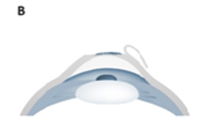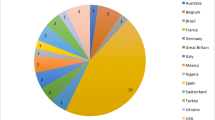Abstract
Purpose
This article aims to present the corneal tattooing method and how using a tattoo pen machine can improve aesthetic appearance in patients with corneal leukoma.
Methods
In this study, 42 patients were evaluated who had no visual potential and who had undergone colored corneal tattooing using an automatic tattoo pen machine for aesthetic purposes. The procedure was conducted according to the principles of the Declaration of Helsinki. The commercially available tattoo ink that has traditionally been used on human skin (brown, green, and black) for years was used for all the patients in this study, and 252 corneal photographs (with a Topcon slit lamp imaging device at 16 magnifications, i.e., 16 ×) taken within the last 2 years were evaluated retrospectively. Red, green, and blue (RGB) and hue, saturation, and lightness (HSL) values of the tattooed areas, such as pupils and iris, in corneal photographs were determined online using the Color Code Finder program. The RGB and HSL values of the pupil and iris were compared before surgery on the first day and first week, first month, third month, and twelfth month after surgery.
Results
In the first postoperative month, the mean pupil lightness (L) and iris L values were found to have increased by 10.7% and 5.7%, respectively. Between the first month and the first year, the L value of the mean pupil and that of the iris increased by 1.7% and 5.2%, respectively. The increase in the RGB value of the mean pupil in the first month was statistically significant (p = 0.02). The highest increase in RGB values of the iris was observed in the first week and first month (p = 0.113). This result shows that the majority of fading occurred in the first month. After the first month, the increase in the L value in the black-colored pupil was less than that in the brown- or green-colored iris. These results show that light colors fade faster and more.
Conclusion
Esthetically, corneal leukoma causes severe psychological problems. Many patients are unable to use prosthetic contact lenses. Evisceration surgery has many complications, and limbal stem cells are used in evisceration surgery. Corneal tattooing using a tattoo pen machine is an easy, practical, and repeatable method used for aesthetic purposes. Successful results require the use of appropriate methods, ink, and ophthalmologist’s experience. All patients in this study had a more aesthetic appearance than the preoperative white eye. Further studies are needed to develop a colored aesthetic tattooing method with a tattoo pen machine.







Similar content being viewed by others
References
Soares IP, França VP (2010) Evisceration and enucleation. Semin Ophthalmol 25(3):94–97. https://doi.org/10.3109/08820538.2010.488575
Al-Shymali O, Rodriguez AE, Amesty MA et al (2019) Superficial keratopigmentation: an alternative solution for patients with cosmetically or functionally impaired eyes. Cornea 38(1):54–61. https://doi.org/10.1097/ICO.0000000000001753
Hasani H, Es’haghi A, Rafatnia S et al (2020) Keratopigmentation: a comprehensive review. Eye (Lond) 34(6):1039–1046. https://doi.org/10.1038/s41433-019-0750-2
Doganay D, Doganay S, Cankaya C (2020) Corneal tattooing for esthetic purposes in patients with corneal opacities. Indian J Ophthalmol 68(6):1033–1036. https://doi.org/10.4103/ijo.IJO_1502_19
Chen B, Shi S, Chen B et al (2021) True color 3D imaging optimization with missing spectral bands based on hyperspectral LiDAR. Opt Express. 29(13):20406–20422. https://doi.org/10.1364/OE.426055
Beliakov G, Bustince H, Paternain D (2012) Image reduction using means on discrete product lattices. IEEE Trans Image Process 21(3):1070–1083. https://doi.org/10.1109/TIP.2011.2168412
Calas E, Gueudry J, Muraine M (2018) Severe color change in corneal tattoos: report of 3 cases. J Fr Ophtalmol 41(10):e469–e475. https://doi.org/10.1016/j.jfo.2018.10.001
Kim C, Kim KH, Han YK et al (2011) Five-year results of corneal tattooing for cosmetic repair in disfigured eyes. Cornea 30(10):1135–1139. https://doi.org/10.1097/ICO.0b013e3181f2391a
Jabbour S, Choremis J, Boutin T et al (2019) Poor long-term outcomes of keratopigmentation with black ink for the treatment of dysphotopsia secondary to laser peripheral iridotomies. Cornea 38(11):1400–1405. https://doi.org/10.1097/ICO.0000000000002117
Jeong J, Fay JD, Lee JK et al (2020) The 3-year outcomes of corneal tattooing for severely disfigured corneas. Int Ophthalmol 40(7):1773–1779. https://doi.org/10.1007/s10792-020-01346-z
Alsmman AH, Mostafa EM, Mounir A et al (2018) Outcomes of corneal tattooing by rotring painting ink in disfiguring corneal opacities. J Ophthalmol 25(2018):5971290. https://doi.org/10.1155/2018/5971290
Ong APC, Zhang J, Vincent AL et al (2021) Megalocornea, anterior megalophthalmos, keratoglobus and associated anterior segment disorders: a review. Clin Exp Ophthalmol 49(5):477–497. https://doi.org/10.1111/ceo.13958
Bromeo AJ, Lim Bon Siong R (2020) Corneal melt following corneal tattooing with carbon-based ink. Am J Ophthalmol Case Rep. 19:100779. https://doi.org/10.1016/j.ajoc.2020.100779
Agarwal R, Urkude J, Nair S et al (2021) Effect of intraoperative optical coherence tomography on anatomic and cosmetic results of intrastromal tattooing. Saudi J Ophthalmol. 35(1):39–46. https://doi.org/10.4103/1319-4534.325784
Rodriguez AE, Amesty MA, El Bahrawy M et al (2017) Superficial automated keratopigmentation for iris and pupil simulation using micronized mineral pigments and a new puncturing device: experimental study. Cornea 36(9):1069–1075. https://doi.org/10.1097/ICO.0000000000001249
Kim JH, Lee D, Hahn TW et al (2009) New surgical strategy for corneal tattooing using a femtosecond laser. Cornea. 28(1):80–4. https://doi.org/10.1097/ICO.0b013e318181a83c
Rodríguez-Avila JO, Ríos Y Valles-Valles D et al (2020) Conjunctival tattoo with inadvertent ocular globe penetration and vitreous involvement: clinico-pathological correlation and scanning electron microscopy X-ray microanalysis. Eur J Ophthalmol. 30(5):NP18–NP22. https://doi.org/10.1177/1120672119850076
Cruz NF, Santos KS, Farah ML et al (2017) Conjunctival tattoo with inadvertent globe penetration and associated complications. Cornea 36(5):625–627. https://doi.org/10.1097/ICO.0000000000001163
Tubek K, Berus T, Leszek R (2019) The girl with the eyeball tattoo-what the ophthalmologist may expect? Case report and a review of literature. Eur J Ophthalmol. 29(5):NP1–NP4. https://doi.org/10.1177/1120672118803855
Amesty MA, Rodriguez AE, Hernández E et al (2016) Tolerance of micronized mineral pigments for intrastromal keratopigmentation: a histopathology and immunopathology experimental study. Cornea 35(9):1199–1205. https://doi.org/10.1097/ICO.0000000000000900
Prinsze FJ, van de Laar T, Slot E et al (2019) No increased risk of transfusion-transmissible infections after tattooing, body piercing, or acupuncture among blood donors in the Netherlands. Transfusion. 59(8):2575–2583. https://doi.org/10.1111/trf.15421
Pradhan S, Das M, Panigrahi AK et al (2015) Severe conjunctival reaction following attempted corneal tattooing. JAMA Ophthalmol. 133(7):854–6. https://doi.org/10.1001/jamaophthalmol.2015.0934
Hida S, Chiambaretta F, Malecaze J (2022) Scleral tattooing: a dangerous fashion trend. J Fr Ophtalmol. 45(6):608–611. https://doi.org/10.1016/j.jfo.2022.01.007. (French)
Islam N, Franks WA (2006) Therapeutic corneal tattoo following peripheral iridotomy complication. Eye (Lond). 20(3):389–90. https://doi.org/10.1038/sj.eye.6701861
Lin HC, Wang YL, Chen GW et al (2016) Corneal tattooing and anterior stromal puncture for treating symptomatic bullous keratopathy. Cornea 35(3):355–357. https://doi.org/10.1097/ICO.0000000000000693
Dawson E, Maino A, Lee J (2009) A unique use for a corneal tattoo. Strabismus 17(3):98–100. https://doi.org/10.1080/09273970903156557
Cha DM, Shin KH, Kim KH et al (2013) Simple keratectomy and corneal tattooing for limbal dermoids: results of a 3-year study. Int J Ophthalmol. 6(4):463–6. https://doi.org/10.3980/j.issn.2222-3959.2013.04.10
Lian RR, Siepser SB, Afshari NA (2020) Iris reconstruction suturing techniques. Curr Opin Ophthalmol 31(1):43–49. https://doi.org/10.1097/ICU.0000000000000628
Segal L, Choremis J, Mabon M (2012) Intrastromal corneal tattooing for symptomatic iridotomies. Br J Ophthalmol 96(3):464–465. https://doi.org/10.1136/bjophthalmol-2011-300923
Alió JL, Rodriguez AE, Toffaha BT et al (2011) Femtosecond-assisted keratopigmentation for functional and cosmetic restoration in essential iris atrophy. J Cataract Refract Surg. 37(10):1744–7. https://doi.org/10.1016/j.jcrs.2011.08.003
Author information
Authors and Affiliations
Corresponding author
Ethics declarations
Ethics approval
All procedures performed in studies involving human participants were by the ethical standards of the (Ethics Committee of Istanbul Medeniyet University Göztepe Training and Research Hospital clinical research. Decision number: 2022/0154) and with the 1964 Helsinki Declaration and its later amendments or comparable ethical standards.
Conflict of interest
The authors declare no competing interests.
Additional information
Publisher's note
Springer Nature remains neutral with regard to jurisdictional claims in published maps and institutional affiliations.
Supplementary Information
Below is the link to the electronic supplementary material.
Supplementary file2 (MP4 161125 KB)
Rights and permissions
Springer Nature or its licensor (e.g. a society or other partner) holds exclusive rights to this article under a publishing agreement with the author(s) or other rightsholder(s); author self-archiving of the accepted manuscript version of this article is solely governed by the terms of such publishing agreement and applicable law.
About this article
Cite this article
Yilmaz, O.F., Oguz, H. Aesthetic corneal tattooing/keratopigmentation using tattoo pen machine: choosing suitable method and color. Graefes Arch Clin Exp Ophthalmol 261, 3531–3540 (2023). https://doi.org/10.1007/s00417-023-06135-9
Received:
Revised:
Accepted:
Published:
Issue Date:
DOI: https://doi.org/10.1007/s00417-023-06135-9




